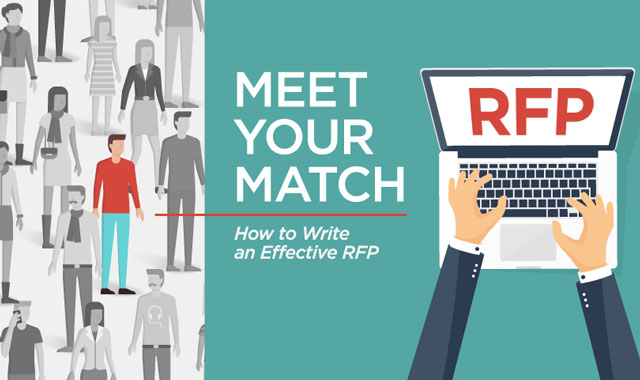As a freelance editor and writer for more than twenty years, Kris McNeely has had the opportunity to write and edit everything from non-fiction books to blog posts, web content to white papers, ads to articles. She was named an Erma Bombeck Humor Writer of the Month, has been featured in multiple anthologies, and was selected by Amtrak Railway Service as one of five travel writers from among a pool of 1500 applicants nationwide. In her free time, she likes to jog, garden, travel, and spend time with her two kids and three grandchildren.
Meet Your Match — How to Write an Effective RFP
Pulling together all the pieces to create a wonderful event can be exhausting. Clearly, booking the right vendor — from venue to caterer, accommodations to entertainment — is critical to your success. Developing an effective RFP at the start of the planning process will not only make it easier, it will help you clarify exactly what you need, saving you hassles and headaches later.
1. Introduction. Briefly describe what you need and include essential information, such as goals and deadlines. This allows your vendor to determine if they have the bandwidth to even begin the process of competing for your business.
2. Who are you? Introduce your organization, what you do, your values, goals, and processes. This doesn’t need to be a novel, but vendors should know enough about your organization that they can offer a relevant response. For example, if you’re planning an event for an agency focused on the environment, a vendor can then speak to your desire for a “green” event that’s eco-friendly. This not only gives vendors an opportunity to spotlight their own specialized services that address your needs, it also ensures that vendors are a good fit.
3. What do you want? Now you can go into detail about your event. Describe your ideas. Do insert details and specifics, but also leave enough latitude so that the vendors can offer ideas or inspiration that might not have occurred to you. Offer details about your attendees, such as profession, age group, gender, etc. Define your specific event goals. What is your event take-away? Should the event promote team-building or a sense of unity? Do you want them to join an organization or make a donation?
4. How can we help you? Explain in detail the information you need to receive from vendors. For example, venue capacity, customized menu planning options, group discounts, technology capabilities, handicap access, accommodation availability, guest perks, etc.
5. What can you afford? You should have a good idea of your budget going into the RFP process. Make sure to indicate what it is and ask for a breakdown of costs that the vendor proposes to charge. Also, request any other relevant financial details you’ll need to make an informed decision, such as deposits and contract terms.
6. When do you want it? Establish a reasonable timeline, including the distribution of the RFP, deadline for vendor questions to you and answers from you, deadline for proposal submission, notification to finalists, interviews, vendor selection, and finally, vendor contract signing.
7. Who do we call? Include contact information (phone numbers, emails) and your preferred format for proposal submission. For example, via email, snail mail, fax, or Dropbox.
Writing an effective RFP can be a time-consuming process the first few times you do it, but you can frequently re-purpose portions of your RFP (i.e., your organization information) for subsequent RFPs. But when thoroughly developed, an effective RFP will always lead you to your perfect match.










